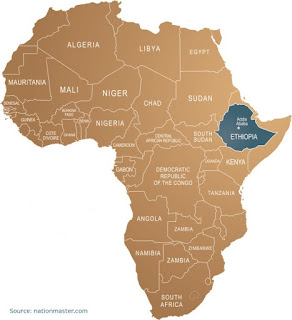The Resources Beneath Our Feet
Last week I touched upon large-scale engineering as a method of utilising, or even controlling, the water resources within Ethiopia in the form the Grand Ethiopian Renaissance Dam. Whilst not directly relating to Ethiopian food production, it got me thinking about the role of engineering in improving Ethiopia’s agricultural output. Consequently, I’ve been doing some digging around the potential for groundwater extraction to supply water for irrigation. In this post I’ll therefore be taking a more in-depth look at groundwater resources within Ethiopia.
When I started looking at groundwater in Africa, I realised more than ever that most of Africa is definitely not just a ‘dry’ continent. Indeed, Africa’s groundwater reservoirs could hold up to 100 times more water than is available at the surface. In Asia, especially post-Green Revolution, groundwater has been instrumental in supporting increased agricultural production. Yet, although some regions in Sub-Saharan Africa (SSA) also utilise available groundwater supplies, Ethiopia all but overlooks the resources beneath its feet.
The spatial distribution of Ethiopia's 30 billion cubic metres of groundwater is, similar to its rainfall, incredibly varied; with the average water depth ranging from approximately 4,800 to almost 17,900 mm across the 12 river basins (see Table 1). Unfortunately, in much of the country the viability of groundwater supported irrigation is poor; as attempts to pump the 20 litres per second (l/s) of water required to sustain pressurised irrigation would rapidly deplete the aquifers. As a result, only 8% of suitable land could be irrigated using shallow groundwater (see Figure 1). However, whilst this is perhaps less than I was expecting, it would still provide a modest amount of farmland with continuous and reliable water supplies, substantially increasing food production. On top of this, groundwater supplies could still be used in many regions within Ethiopia to supplement the available surface water resources. This would be particularly important during times of reduced rainfall and could be influential in reducing the food instability that is too frequently the outcome at present.
 |
| Table 1: The average groundwater storage, yield and depth for Ethiopia's twelve major river basins |
 |
| Figure 1: The percentage of groundwater using irrigable land within Ethiopia |
The Raya valley is one such area in which groundwater resources could be used more extensively for irrigation. Located in the highlands of northern Ethiopia (see Figure 2), the valleys total land area is approximately 2,480 km2, with a projected 28.4% of that currently under cultivation. Despite the valley having an estimated annual groundwater recharge of 84 million cubic metres, most of which is predicted to be only moderately saline and therefore suitable for irrigation, the region frequently experiences water stress. Incredibly, only 0.06% of the available groundwater is currently used for irrigation. The potential for using groundwater for irrigation, at least in some parts of Ethiopia, therefore seems a substantial but as of yet underexploited opportunity.
 |
| Figure 2: Location of the Raya valley in the northern highlands of Ethiopia |
In recognition of this potential, groundwater irrigation has become a greater focus within the Ethiopian Ministry of Water, Irrigation and Electricity and in the 1990s the Golgol Raya Development Projects was initiated with the aim of developing groundwater irrigation throughout the valley. However, a study of the progress made across the two woredas (districts) in the Raya valley showed that of the 128 deep wells that were drilled for irrigation, just eight remained operational. Whilst these eight wells provide enough water for the irrigation of 272 hectares, benefiting some 680 people, they account for just 0.8% of the land originally outlined for the development of groundwater irrigation. Although studies of groundwater use in the Raya valley are limited, it has been found that groundwater irrigation is profitable for farmers and it is widely agreed that increased investment in groundwater irrigation could be instrumental in improving people’s livelihoods.
Evidently, the problem is not that of too little water, as just a fraction of potential groundwater in the Raya Valley is being used; rather, it is continued poor management of resource development and capacity restrictions at all levels of governance. A lack of financial capacity within the government to invest appropriately in such infrastructure inhibits the utilisation of available resources. Even when projects are initiated the scheme is poorly managed, leading to a deterioration in effectiveness, as is the case in the Raya valley. Whereby despite the construction of a number of wells, they were not extended or maintained as planned, and broken pumps often not replaced for extended periods of time. This leads to overall poor efficiency and weak implementation and ultimately, the continued under exploitation of a resource which could be used to relieve the pressures on Ethiopia’s food production that I’ve been exploring throughout this blog.
Once again we return to the issue of economic water scarcity. Groundwater could sustain irrigation across 8% of Ethiopia’s irrigable land. Yet, due to poor governance and lack of finance, the country continues to face a surprising level of water scarcity, with consequences for its food security. Addressing the issues of resource management and promoting cost sharing schemes between farmers and government both offer routes forward in the area of groundwater development. However the successful implementation of such approaches has yet to be seen and it is safe to say that the process of introducing the effective management required for large-scale groundwater development will continue for the foreseeable future.
On that rather sombre note I’ll leave you for another week, but try not to be too disheartened, I’ll return after Christmas with some positive recommendations for Ethiopian water management just in time for the New Year. Merry Christmas to you all, I hope you have a wonderful break!


Comments
Post a Comment